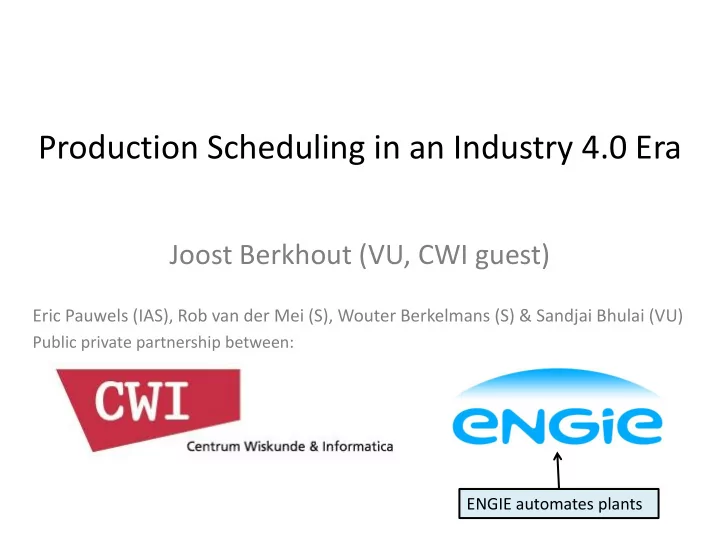

Production Scheduling in an Industry 4.0 Era Joost Berkhout (VU, CWI guest) Eric Pauwels (IAS), Rob van der Mei (S), Wouter Berkelmans (S) & Sandjai Bhulai (VU) Public private partnership between: ENGIE automates plants
Content Presentation • Scheduling in animal-feed plants • Research approach • Results • Concluding remarks
Scheduling in Animal-Feed Plants World-wide: 𝟐𝟏 𝟐𝟑 kg • • 120 plants in Holland • Production aspects: Customer order due dates Contamination Changeover times …
Production Scheduling Problem Trends: ‘big data’ & mass-customization (industry 4.0) Goal: How to efficiently schedule orders to meet due dates? Current situation: planners ‘schedule by hand’ ... As a result: time-consuming and opportunity loss (inflexible and ‘big data’ unused)
Research Approach: Mixed integer linear programming (MILP): MILP implementation: Simplification: Accuracy testing: Schedule advice: Solve MILP: “Common sense” (Darwin)
MILP solving strategies: For small instances: For example: only consider (max. 3 hour time horizon) schedules that produce roughly in order of the customer order due dates For medium instances: “Common sense” (max. 6 hour time horizon) For large instances: (> 6 hour time horizon) Evolutionary computing on bottleneck production area* * By extending the ideas from “Expanding from Discrete Cartesian to Permutation Gene-pool Optimal Mixing Evolutionary Algorithms ” from Bosman et al. (2016) to flexible flowshops
Results: Example of a realized schedule:
Results: Optimized schedule: Solved for 180 seconds, 23 minutes earlier finished (7.5%)
Results (Efficiency Gain): Comparison to realized schedules for 267 instances (5h) when solving for 180 seconds (all found schedules respect the due dates) WED: solving MILP with “common sense”
Concluding Remarks • Model is implemented in a pilot plant in Limburg (for testing w.r.t. accuracy and optimization gain) • Further research: – Model extension (transport and finished product silos) – Further development of (tailored) heuristics – Taking stochastic nature into account: Robust optimization Efficient rescheduling (emergency order, machine breakdown)
Thanks for your attention! Any questions? Mail: j2.berkhout@vu.nl
Recommend
More recommend